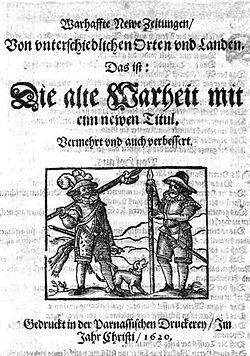Parnassic printing house
Parnassian printing , Parnassic book truckerey , Parnasische Officin , Parnassic Hoffschneiderey o. Ä. Is a fictional printing company , which was given in the early baroque period at the beginning of the Thirty Years' War as a cipher when publishing anonymous or pseudonymous writings.
The name alludes to Mount Parnassus , which in Greek mythology is dedicated to Apollo and is considered the home of the muses , the goddesses of the arts. The place is committed to the truth in a special way .
A place of printing is not specified, if need be, the fictitious place of publication “auf'm Parnasso”, “Monte Parnasso or Spitzberg” or similar. called. The actual printing locations of writings allegedly published in the "Parnassian Printing House" include: a. Strasbourg or Prague suspected.
Used pseudonyms are e.g. B .:
- Boccalinus, Almanus (1624)
- "Cappuciner Münch" (1618)
- Cornelius, Justus (1619)
- Democritus Risibilis (= "the laughable") (1623; = Heraclitus Flebilis Pelasgos)
- Heraclitus Flebilis (= "the lamentable") Pelasgos (1623; = Democritus Risibilis)
- Frange-panem et Mangge-formaggium, Isbertus, Cittadin del Bebe vino (1624)
- Friederich, Christian (1622)
- Hisaias (Isaias) sub cruce (1619; = Mag.Simpert Wehe )
- Huss redivivus, Johann (1619); probably = Johann von Roerig, Johannes Meder or Samuel Martinius
- Jonaeman von Wahrpurg, Jeremias (1618; 1619)
- Persuasor, Fagabundus (1626)
- Procopius, Johannes (1619; = Friedrich Grick)
- Q [uintus] Curtius Manl [i] us
- Salerma, Reinmundus de (1622; = Christian Friederich)
- Zoanettus, Philippus (1619; probably = Friedrich Grick)
Published under his real name
in the Parnassic printing house.
Some of the writings were created in connection with the Ulm comet controversy in 1618 and the dispute over Rosicrucianism .
Theophil Dachtler (* around 1553/54; † after 1630), Zacharias Theobald (1584–1627) and Julius Wilhelm Zincgref (1591–1635) are suspected of being among the anonymous authors who used the “Parnassian Printing House” .
Similarly, “Heliconische Druckerei” is also used as a fictitious printing location; Mount Helicon was the seat of the Muses until they were brought to Parnassus by Apollo.
"Collegium zu Sanct Passier", allegedly in Passau , in reference to the Jesuit college in Passau founded there in 1612, was specified as the printing company for some anti-Jesuit pamphlets of this time .
literature
- Emil Weller : The Masked Literature of Older and Newer Languages , Vol. I Index Pseudonymorum , Leipzig: Falcke & Rössler 1856.
- Emil Weller: Supplements to the Index Pseudonymorum , Leipzig: Falcke & Rössler 1857.
- Emil Weller: New supplements to the index pseudonymorum and to the Faschen and fake printing locations , Leipzig: Falcke & Rössler 1862.
- Emil Weller: The wrong and fake print locations. Repertory of the German, Latin and French fonts that have been published under a false company since the art of printing was invented , Volume I containing the German and Latin fonts , Volume II containing the French fonts / Dictionnaire des ouvrages francais des lieux d'impression et des imprimeurs , 2. Edition Leipzig: Wilhelm Engelmann 1864.
- Emil Weller: Index pseudonymorum . Dictionary of pseudonyms or index of all authors who used false names . Third supplement booklet. New additions to the “false and false print sites” Second edition. Leipzig 1864 , Glauchau / Leipzig: Theobald Moritz 1867.
- Julius Opel / Ludwig Adolf Cohn : The Thirty Years War . A collection of historical poems and prose presentations, Halle: Verlag des Waisenhauses 1861, pp. 480–484. ( Digitized version ).
Individual evidence
- ↑ The "German Boccalinus"; probably an allusion to Traiano Boccalini (1556–1613): De 'Ragguagli di Parnaso , centuria prima / seconda, Venice: Pietro Farri 1612/13; Pietra del paragone politico tratta dal monte Parnasso , dove si toccano i governi delle maggiori monarchy dell 'universo, "Cosmopoli" [Venice]: Francesco Prati 1615 = German: Politischer Probierstein auss Parnasso . Thereupon the fornembstem Monarchy and Freyen stalls all over the world, governments deleted, and which is to be seen, o. O. 1616, vol. II. Relation aus Parnasso . Or Political and Moral Discurs, like the same of all kinds of world trades, o. O. 1617, Vol. III. Political touchstone from Parnasso . Proceeding from all kinds of historical, political and moral discourses and dealings in this way, n.d. 1618.
- ^ As "Justus Cornelius Cosmopolita" letter partner of Friedrich Grick, Johannes Faulhaber (1580–1635) defended in the Ulm comet dispute , perhaps the Tübingen student "Justus Cornelius Gölzer Tuttlingensis" ; see. Urich Neumann: "Olim, since the roses Creutzerey is still flourishing, called Theophilus Schweighart". Wilhelm Schickard's friend and correspondent Daniel Mögling (1596–1635) . In: Friedrich Seck (ed.): On the 400th birthday of Wilhelm Schickard , Stuttgart: Franz Steiner Verlag 1995, pp. 93–115, especially p. 109.
- ↑ According to an ancient saying, " Heraclitus of Ephesus wept for what Democritus of Abdera found ridiculous" ; Heraclitus and Democritus were seen as the weeping and the laughing philosopher. The author may also use the pseudonyms "Christodorus Pistopatriota" and "Christian (us) Friederich".
- ↑ Means roughly "Isbert bread-break and cheese-eat, citizens drink wine".
- ↑ Also Zimprecht, Zimbertus Wehe u. Ä .; 1610 pastor in Jungingen, 1618 teacher of Latin in Ulm, 1620 to 1629 pastor in Reilingen, then in Hungary.
- ↑ Also "Johann-Philipp Cuspinianus".
- ^ Theologian from Wittenberg.
- ↑ From Dražov (1593–1639); Expelled from Prague as a Protestant pastor in 1621, pastor in Pirna from 1626, maintained a printing press, in Prague in 1631, then again in Pirna.
- ↑ From Wesel, * around 1595, 1615 matriculated in Altdorf as a student. jur. "Fridericus Gryckius Clivovesaliensis" , Preceptor , author of satirical, apparently defensive writings against the Rosicrucians under various pseudonyms , involved in the Ulm comet dispute, † after 1621.
- ↑ "Q. Cvrtii ManLI ”, possibly an anagram .
- ^ Rector of the Ulm School, * around 1580 in Augsburg, † 1638 in Ulm.
